HA2022 Business Law Assignment: Contract and Negligence Analysis
VerifiedAdded on 2022/11/13
|10
|1210
|412
Report
AI Summary
This document presents a comprehensive analysis of a business law assignment, addressing two key legal areas: contract law and negligence. Part A of the assignment examines a scenario involving a partnership agreement, focusing on the formation of a valid contract, offer, acceptance, and legal intent. It then assesses whether a breach of contract occurred when one party left the business and started a rival venture. Part B delves into the law of negligence, analyzing a case where a person was injured in a car accident involving a drunk driver. The analysis covers the elements of negligence, including duty of care, breach of duty, and damages, and explores the defense of contributory negligence. The assignment utilizes the IRAC method (Issue, Rule, Application, Conclusion) to structure the legal arguments and incorporates relevant case laws and legal principles to support the conclusions. The document includes a detailed reference list of books, articles, and case laws, which provide a solid foundation for understanding the legal concepts discussed.

Assignment
Part A
Part A
Paraphrase This Document
Need a fresh take? Get an instant paraphrase of this document with our AI Paraphraser
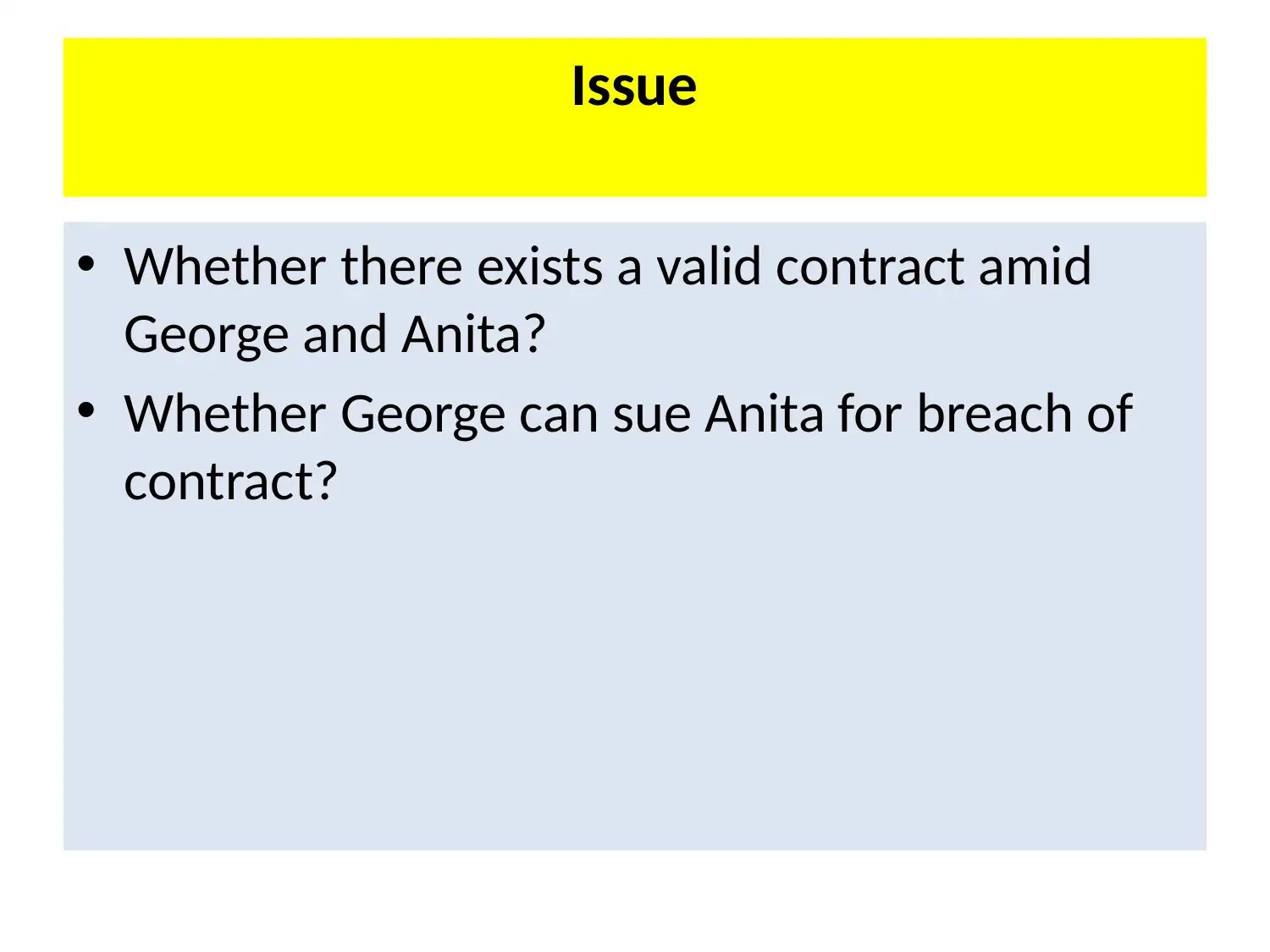
Issue
• Whether there exists a valid contract amid
George and Anita?
• Whether George can sue Anita for breach of
contract?
• Whether there exists a valid contract amid
George and Anita?
• Whether George can sue Anita for breach of
contract?
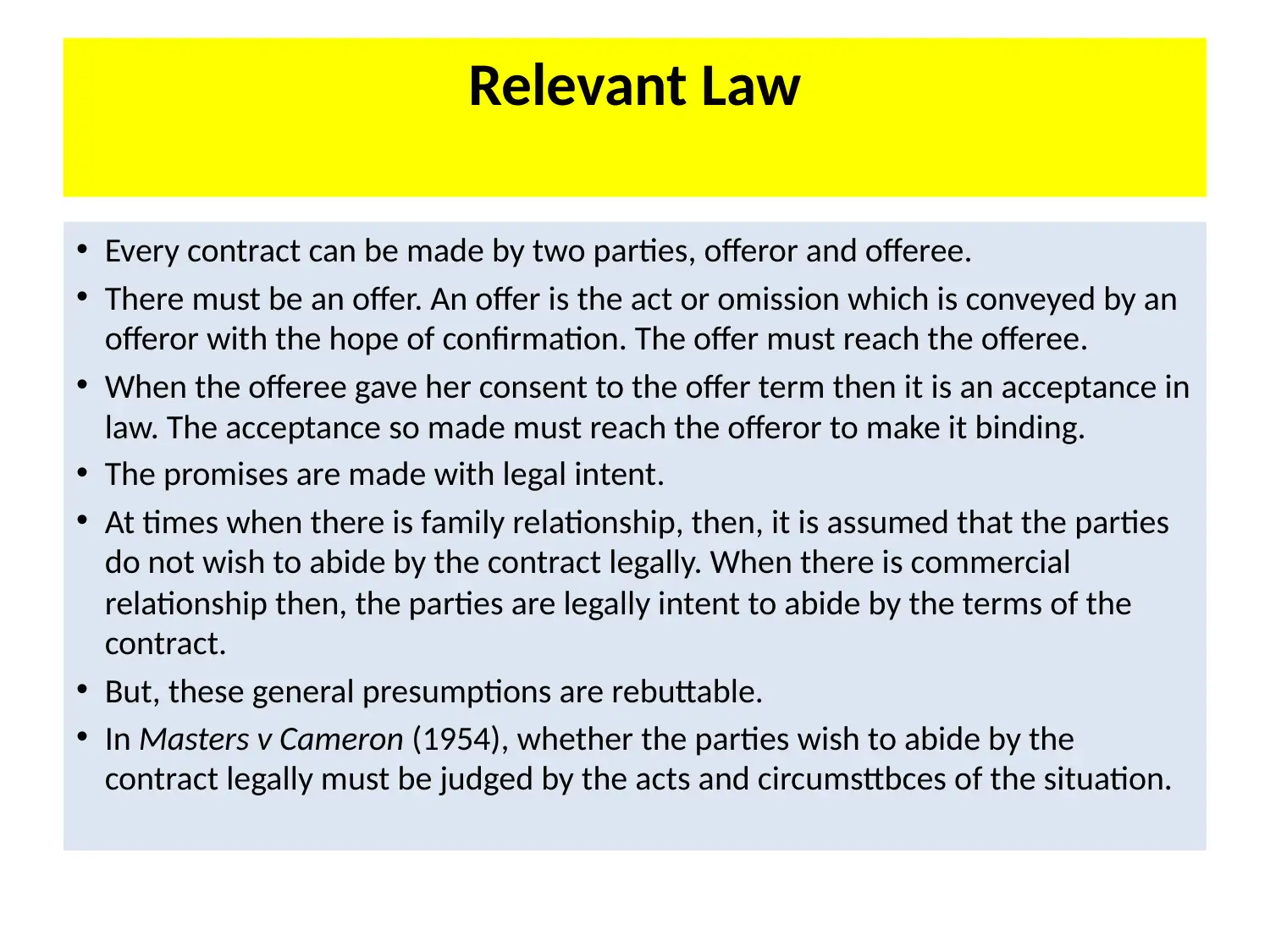
Relevant Law
• Every contract can be made by two parties, offeror and offeree.
• There must be an offer. An offer is the act or omission which is conveyed by an
offeror with the hope of confirmation. The offer must reach the offeree.
• When the offeree gave her consent to the offer term then it is an acceptance in
law. The acceptance so made must reach the offeror to make it binding.
• The promises are made with legal intent.
• At times when there is family relationship, then, it is assumed that the parties
do not wish to abide by the contract legally. When there is commercial
relationship then, the parties are legally intent to abide by the terms of the
contract.
• But, these general presumptions are rebuttable.
• In Masters v Cameron (1954), whether the parties wish to abide by the
contract legally must be judged by the acts and circumsttbces of the situation.
• Every contract can be made by two parties, offeror and offeree.
• There must be an offer. An offer is the act or omission which is conveyed by an
offeror with the hope of confirmation. The offer must reach the offeree.
• When the offeree gave her consent to the offer term then it is an acceptance in
law. The acceptance so made must reach the offeror to make it binding.
• The promises are made with legal intent.
• At times when there is family relationship, then, it is assumed that the parties
do not wish to abide by the contract legally. When there is commercial
relationship then, the parties are legally intent to abide by the terms of the
contract.
• But, these general presumptions are rebuttable.
• In Masters v Cameron (1954), whether the parties wish to abide by the
contract legally must be judged by the acts and circumsttbces of the situation.
⊘ This is a preview!⊘
Do you want full access?
Subscribe today to unlock all pages.

Trusted by 1+ million students worldwide

Application of law
• Anita and George are friends and wish to start a fast food business together.
• A deed of partnership is prepared and both the parties sign the deed.
Issue 1
Anita left the shop and established a new business. There is a valid contract that is
made amid George and Anita. A partnership deed was established by the solicitors
and was signed by both the parties. George and Anita were friends and thus there is
no contractual relationship amid them. But, as per Simpkins v Pays [1955]), by
signing the deed of partnership by both George and Anita have intended to abide by
the deed. So, there is a clear offer and acceptances that are shared by Anita and
George and that there also is a presence of legal intention amid the parties.
Issue 2
There is a valid contract that is made amid Anita and George, thus, Anita by leaving the
business without any due notice and opening a rival business has resulted in the
violation of the terms of the deed of partnership and thus there is a clear breach of
contract on the part of Anita.
• Anita and George are friends and wish to start a fast food business together.
• A deed of partnership is prepared and both the parties sign the deed.
Issue 1
Anita left the shop and established a new business. There is a valid contract that is
made amid George and Anita. A partnership deed was established by the solicitors
and was signed by both the parties. George and Anita were friends and thus there is
no contractual relationship amid them. But, as per Simpkins v Pays [1955]), by
signing the deed of partnership by both George and Anita have intended to abide by
the deed. So, there is a clear offer and acceptances that are shared by Anita and
George and that there also is a presence of legal intention amid the parties.
Issue 2
There is a valid contract that is made amid Anita and George, thus, Anita by leaving the
business without any due notice and opening a rival business has resulted in the
violation of the terms of the deed of partnership and thus there is a clear breach of
contract on the part of Anita.
Paraphrase This Document
Need a fresh take? Get an instant paraphrase of this document with our AI Paraphraser
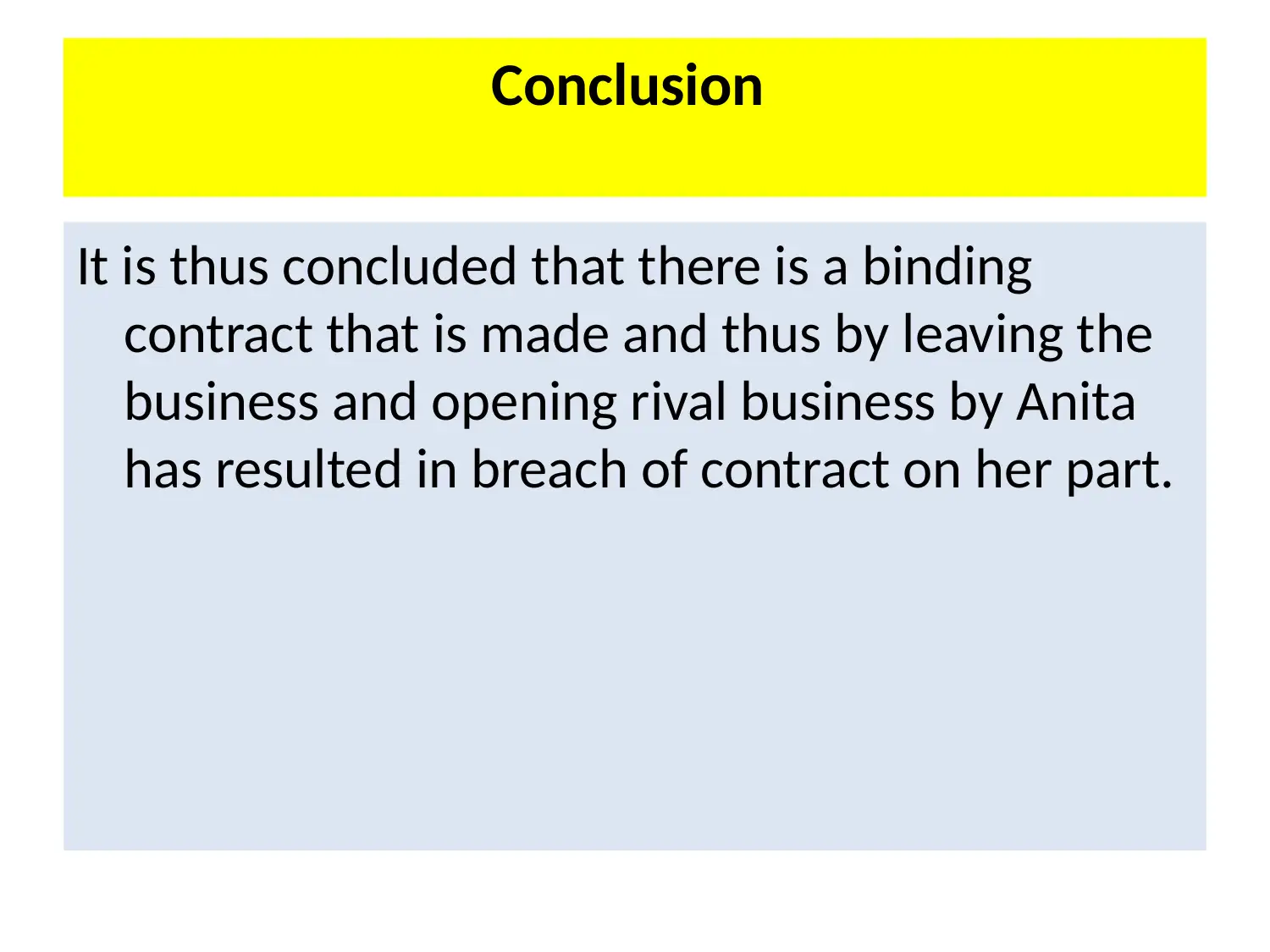
Conclusion
It is thus concluded that there is a binding
contract that is made and thus by leaving the
business and opening rival business by Anita
has resulted in breach of contract on her part.
It is thus concluded that there is a binding
contract that is made and thus by leaving the
business and opening rival business by Anita
has resulted in breach of contract on her part.

PART B
Issue
• Can Anna sue Michael under negligence?
• What ingredients must be proved to hold
Michael liable under negligence?
• Whether there are any defences that can be
raised by Michael?
Issue
• Can Anna sue Michael under negligence?
• What ingredients must be proved to hold
Michael liable under negligence?
• Whether there are any defences that can be
raised by Michael?
⊘ This is a preview!⊘
Do you want full access?
Subscribe today to unlock all pages.

Trusted by 1+ million students worldwide
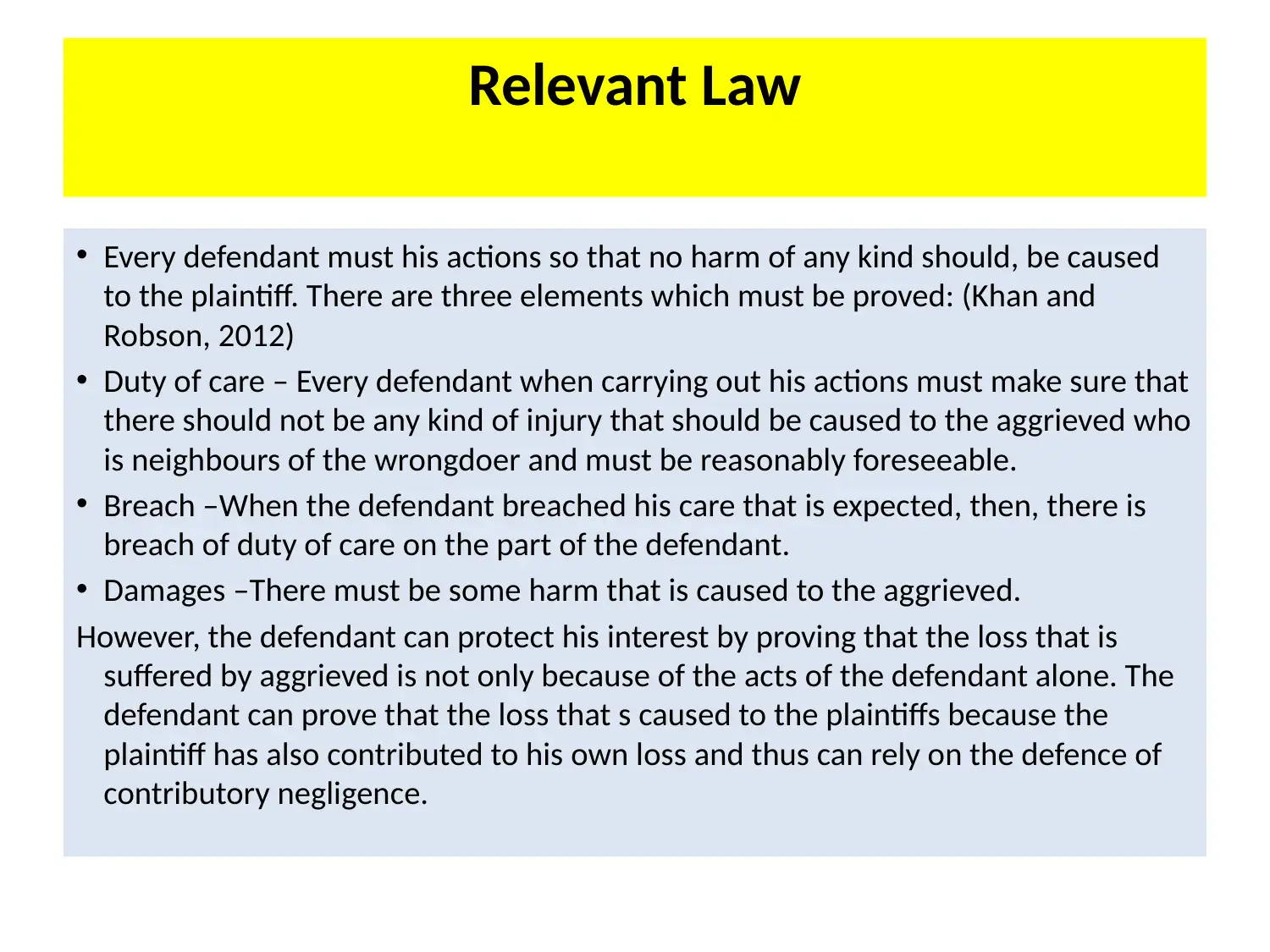
Relevant Law
• Every defendant must his actions so that no harm of any kind should, be caused
to the plaintiff. There are three elements which must be proved: (Khan and
Robson, 2012)
• Duty of care – Every defendant when carrying out his actions must make sure that
there should not be any kind of injury that should be caused to the aggrieved who
is neighbours of the wrongdoer and must be reasonably foreseeable.
• Breach –When the defendant breached his care that is expected, then, there is
breach of duty of care on the part of the defendant.
• Damages –There must be some harm that is caused to the aggrieved.
However, the defendant can protect his interest by proving that the loss that is
suffered by aggrieved is not only because of the acts of the defendant alone. The
defendant can prove that the loss that s caused to the plaintiffs because the
plaintiff has also contributed to his own loss and thus can rely on the defence of
contributory negligence.
• Every defendant must his actions so that no harm of any kind should, be caused
to the plaintiff. There are three elements which must be proved: (Khan and
Robson, 2012)
• Duty of care – Every defendant when carrying out his actions must make sure that
there should not be any kind of injury that should be caused to the aggrieved who
is neighbours of the wrongdoer and must be reasonably foreseeable.
• Breach –When the defendant breached his care that is expected, then, there is
breach of duty of care on the part of the defendant.
• Damages –There must be some harm that is caused to the aggrieved.
However, the defendant can protect his interest by proving that the loss that is
suffered by aggrieved is not only because of the acts of the defendant alone. The
defendant can prove that the loss that s caused to the plaintiffs because the
plaintiff has also contributed to his own loss and thus can rely on the defence of
contributory negligence.
Paraphrase This Document
Need a fresh take? Get an instant paraphrase of this document with our AI Paraphraser

Application of law
• Ann took a lift from Michael when he was too drunk . Michael loose the power of the car and
hit a tree. Both Anna and Michael were suffered with injuries.
• Yes, Anna can sue Michael under the law of negligence. There was duty of care that was
imposed on Michael which was breached by him and which resulted in causing harm to Anna.
• Michael is found to be under duty of care towards Anna as any kind of driving will affect Anna
and thus Anna is the neighbour of Michael. Also, Anna is reasonably foreseeable.
• The duty of care that is imposed upon Michael was no cater by Michael in an adequate
manner.
• Because of the breach of the duty of care on the part of Michael, he lost the control over the
car and hit the tree. Because of the crash, both Michael and Anna sustain injuries.
Thus, Anna can hold Michael liable for the loss caused to her under the law of negligence.
• Michael can rely on the defence of contributory negligence. Anna was aware that Michael
was drunk and still chooses to travel with him. She is aware that driving with alcohol might
result in causing accidents. She herself contributed to her own loss and thus is also liable for
the injuries that are sustained by her. So, Michael can rely on the defence of contributory
negligence.
• Ann took a lift from Michael when he was too drunk . Michael loose the power of the car and
hit a tree. Both Anna and Michael were suffered with injuries.
• Yes, Anna can sue Michael under the law of negligence. There was duty of care that was
imposed on Michael which was breached by him and which resulted in causing harm to Anna.
• Michael is found to be under duty of care towards Anna as any kind of driving will affect Anna
and thus Anna is the neighbour of Michael. Also, Anna is reasonably foreseeable.
• The duty of care that is imposed upon Michael was no cater by Michael in an adequate
manner.
• Because of the breach of the duty of care on the part of Michael, he lost the control over the
car and hit the tree. Because of the crash, both Michael and Anna sustain injuries.
Thus, Anna can hold Michael liable for the loss caused to her under the law of negligence.
• Michael can rely on the defence of contributory negligence. Anna was aware that Michael
was drunk and still chooses to travel with him. She is aware that driving with alcohol might
result in causing accidents. She herself contributed to her own loss and thus is also liable for
the injuries that are sustained by her. So, Michael can rely on the defence of contributory
negligence.

Conclusion
• Anna can sue Michael under negligence as
there was duty of care that was imposed upon
Michael which was breached upon by him.
However, Michael can rely on the defence of
contributory negligence as Anna choose to
travel with Michael knowing the fact that he
was drunk and might cause accident, thus, she
also contributed to her own loss.
• Anna can sue Michael under negligence as
there was duty of care that was imposed upon
Michael which was breached upon by him.
However, Michael can rely on the defence of
contributory negligence as Anna choose to
travel with Michael knowing the fact that he
was drunk and might cause accident, thus, she
also contributed to her own loss.
⊘ This is a preview!⊘
Do you want full access?
Subscribe today to unlock all pages.

Trusted by 1+ million students worldwide
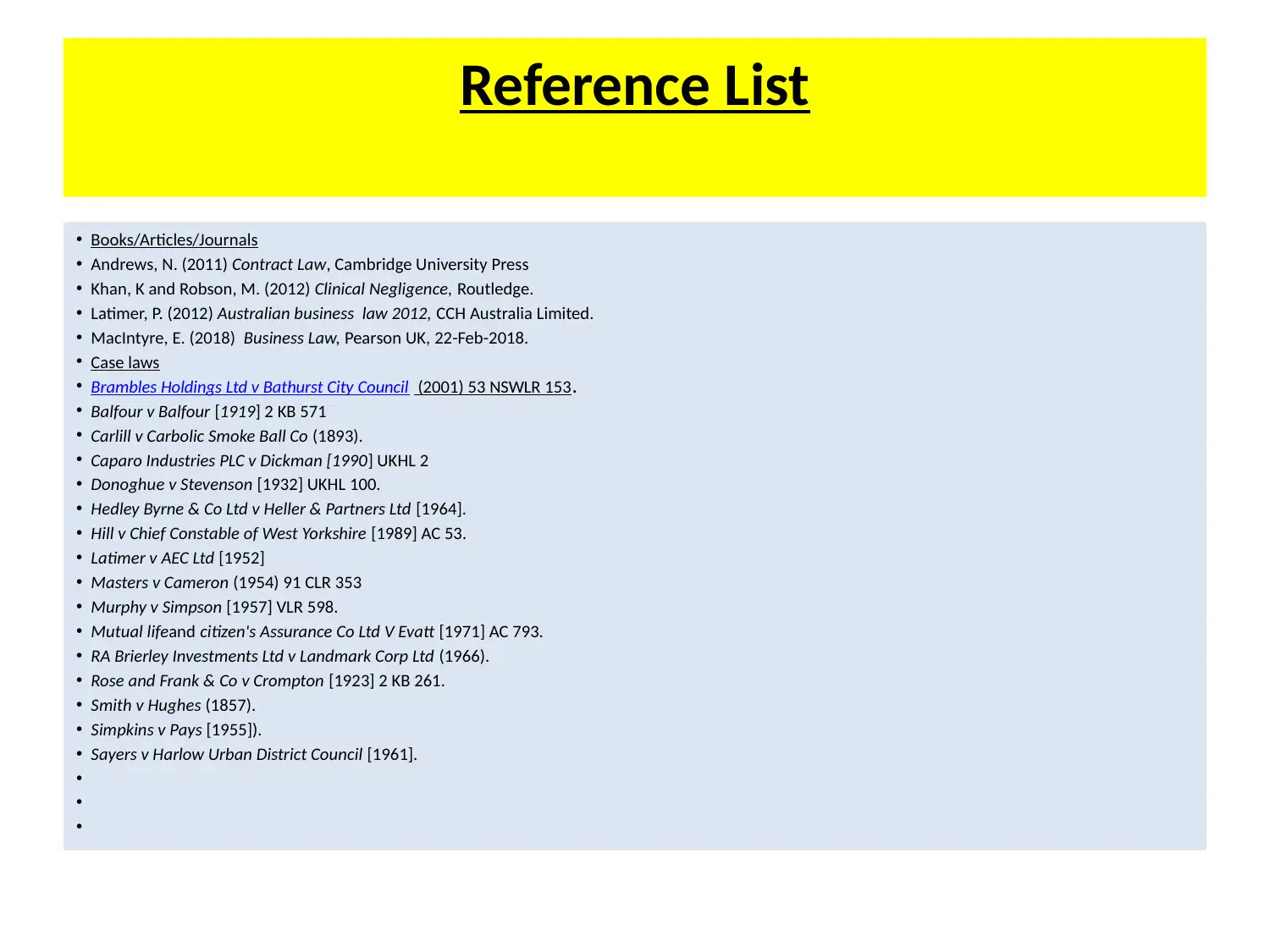
Reference List
• Books/Articles/Journals
• Andrews, N. (2011) Contract Law, Cambridge University Press
• Khan, K and Robson, M. (2012) Clinical Negligence, Routledge.
• Latimer, P. (2012) Australian business law 2012, CCH Australia Limited.
• MacIntyre, E. (2018) Business Law, Pearson UK, 22-Feb-2018.
• Case laws
• Brambles Holdings Ltd v Bathurst City Council (2001) 53 NSWLR 153.
• Balfour v Balfour [1919] 2 KB 571
• Carlill v Carbolic Smoke Ball Co (1893).
• Caparo Industries PLC v Dickman [1990] UKHL 2
• Donoghue v Stevenson [1932] UKHL 100.
• Hedley Byrne & Co Ltd v Heller & Partners Ltd [1964].
• Hill v Chief Constable of West Yorkshire [1989] AC 53.
• Latimer v AEC Ltd [1952]
• Masters v Cameron (1954) 91 CLR 353
• Murphy v Simpson [1957] VLR 598.
• Mutual lifeand citizen's Assurance Co Ltd V Evatt [1971] AC 793.
• RA Brierley Investments Ltd v Landmark Corp Ltd (1966).
• Rose and Frank & Co v Crompton [1923] 2 KB 261.
• Smith v Hughes (1857).
• Simpkins v Pays [1955]).
• Sayers v Harlow Urban District Council [1961].
•
•
•
• Books/Articles/Journals
• Andrews, N. (2011) Contract Law, Cambridge University Press
• Khan, K and Robson, M. (2012) Clinical Negligence, Routledge.
• Latimer, P. (2012) Australian business law 2012, CCH Australia Limited.
• MacIntyre, E. (2018) Business Law, Pearson UK, 22-Feb-2018.
• Case laws
• Brambles Holdings Ltd v Bathurst City Council (2001) 53 NSWLR 153.
• Balfour v Balfour [1919] 2 KB 571
• Carlill v Carbolic Smoke Ball Co (1893).
• Caparo Industries PLC v Dickman [1990] UKHL 2
• Donoghue v Stevenson [1932] UKHL 100.
• Hedley Byrne & Co Ltd v Heller & Partners Ltd [1964].
• Hill v Chief Constable of West Yorkshire [1989] AC 53.
• Latimer v AEC Ltd [1952]
• Masters v Cameron (1954) 91 CLR 353
• Murphy v Simpson [1957] VLR 598.
• Mutual lifeand citizen's Assurance Co Ltd V Evatt [1971] AC 793.
• RA Brierley Investments Ltd v Landmark Corp Ltd (1966).
• Rose and Frank & Co v Crompton [1923] 2 KB 261.
• Smith v Hughes (1857).
• Simpkins v Pays [1955]).
• Sayers v Harlow Urban District Council [1961].
•
•
•
1 out of 10
Related Documents
Your All-in-One AI-Powered Toolkit for Academic Success.
+13062052269
info@desklib.com
Available 24*7 on WhatsApp / Email
![[object Object]](/_next/static/media/star-bottom.7253800d.svg)
Unlock your academic potential
Copyright © 2020–2025 A2Z Services. All Rights Reserved. Developed and managed by ZUCOL.


